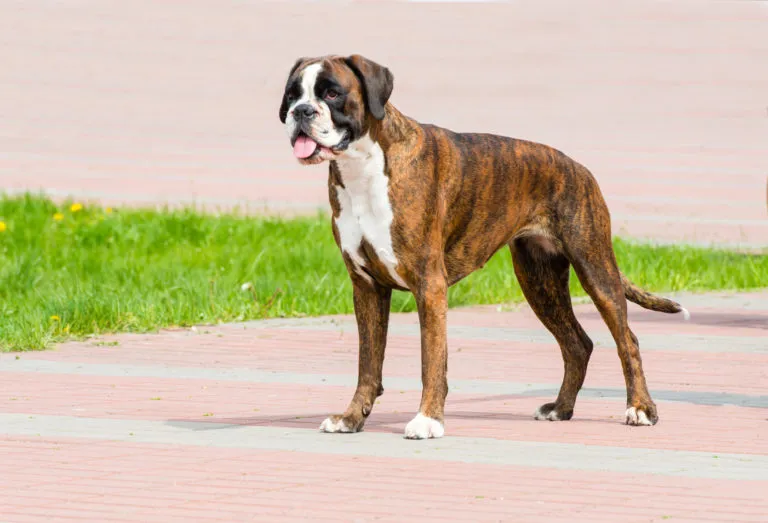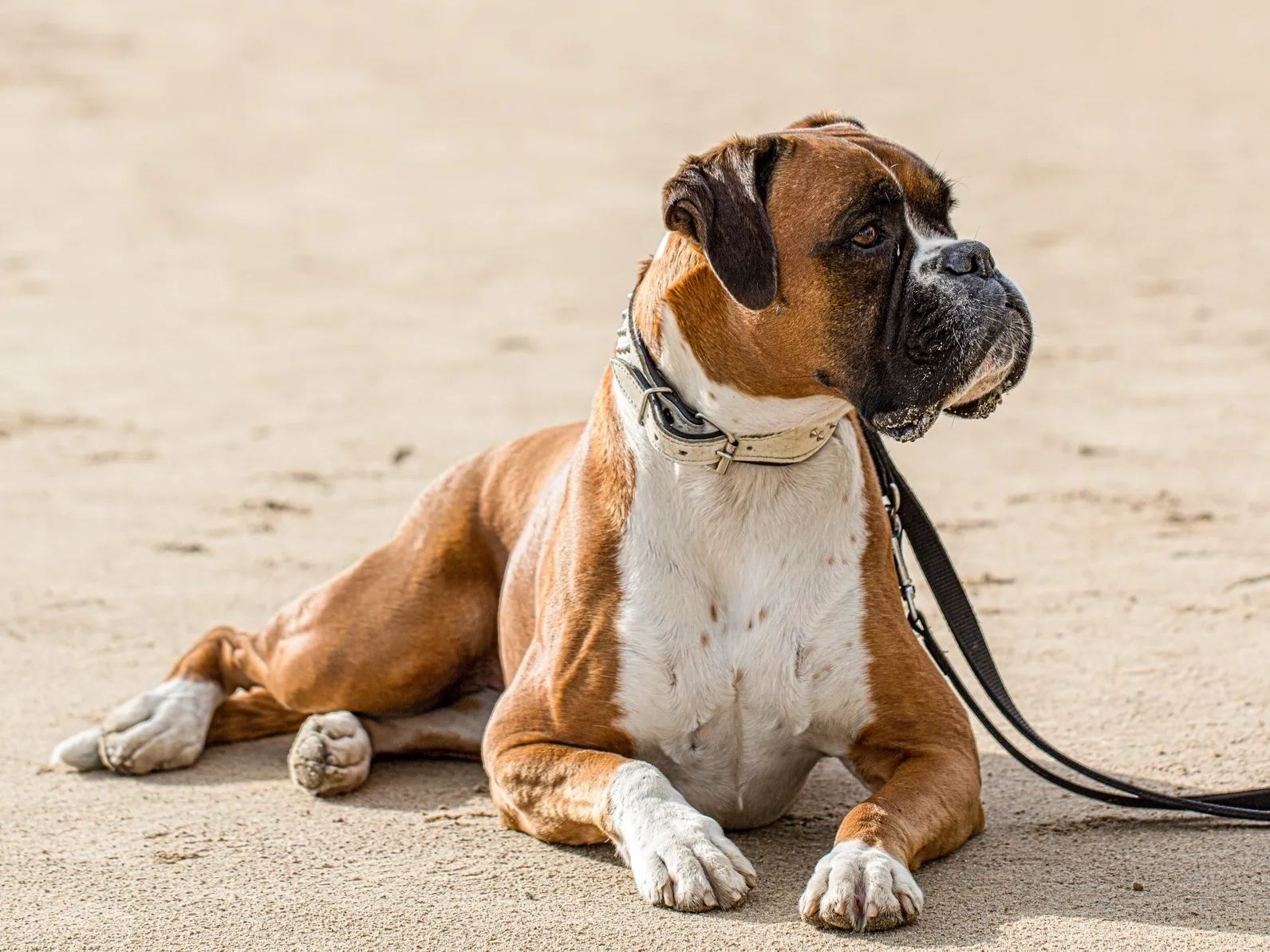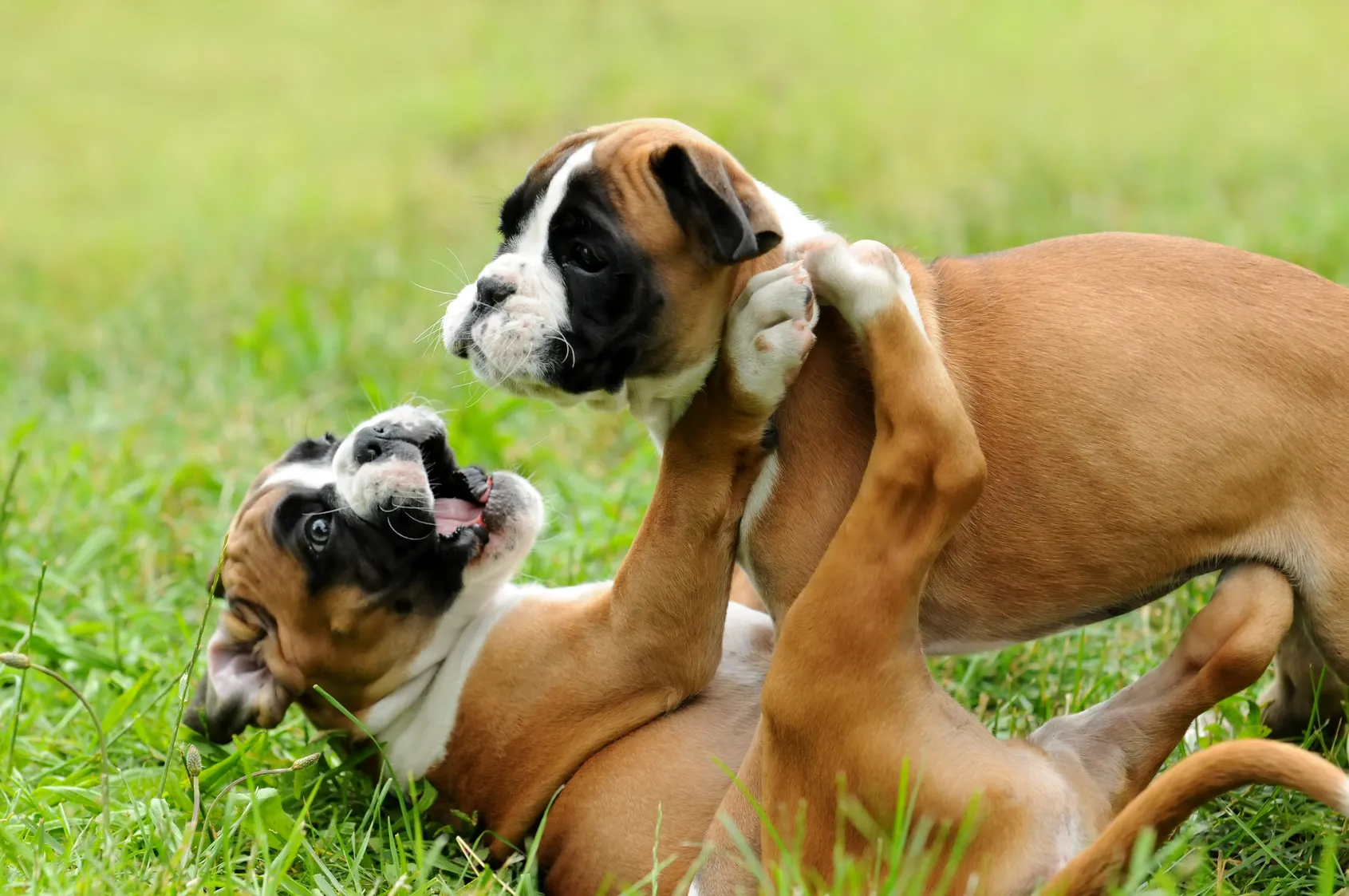Medium Size Poodle
Sturdy and nimble, stubborn and balanced, peaceful and defensive - the German boxer is full of contradictions, but this versatility makes the boxer such a great all-rounder.

© cynoclub / stock.adobe.com
The Boxer may be a fantastic family pet, but it is also a very talented working dog, used in a variety of roles including as a guard dog, rescue dog, as well as in guide dog and sporting roles. Boxer dogs are generally good natured and can make good playmates for children and adults. Boxers tackle any task with merit.
The Boxer tends to be willing to subordinate themselves, which makes them easy to train. People who know Boxers describe them as uncomplicated and willing to learn, friendly to humans, without deceit. Thanks to their calm and balanced nature, they are ideally suited as family dogs, even feeling comfortable in families with small children. Boxer dogs love children and are patient and long-suffering, even with the most boisterous little ones, and will be happy to race and play, even into old age.
Boxers are extremely close with their families and incredibly loyal, which also makes them very alert to anything that might harm their happy home. Boxers may therefore be slow to trust strangers, and in extreme cases they will not hold back in defending their owners. They are known for their courage and tenacity, which makes them very reliable guard dogs, comparing well with similar breeds. However they very rarely react with a bite or viciousness. Once his person signals that everything is safe, he is easy to win over and quick to make new friends.
The boxer has nerves of steel and lots of self-confidence, which gives them great self-control. This steadiness helps to unify all of the initially contradictory character traits into a harmonious whole.
The German Boxer doesn’t just have a great character, he also has a truly unmistakable appearance. The head has a slender and angular skull, with a broad and powerful jaw. Another typical characteristic is the so-called pre-bite, with the lower jaw projecting out below the upper jaw only so far that the upper lip is still supported by the teeth of the longer lower jaw. The dark mask of the muzzle is distinct from the head color and Boxers are described by the FCI yellow or brindle color variants. The yellow basic color ranges from light yellow to dark red, with the red-yellow middle tones being preferred. In the case of striped boxers, the dark or black streaks (flow) must stand out clearly from the yellow basic color and white badges may not cover more than one third of the body surface.
The short, smooth and close-fitting coat emphasizes the strong and muscular stature of the German boxer. Despite their sturdy physique, Boxers are anything but clumsy or tame. Their vigorous movements, in which the muscled hind legs are particularly evident, show the whole power and grace of this breed. The physique of the boxer is square, so the height at the withers corresponds to the body length. The powerful round neck runs in an elegant curve from the neck to the shoulder.
The tail and ears now have a natural look by law and breed standard. Ear cropping, which involved amputating parts of the auricle in seven week old puppies, is now illegal, as is docking your Boxer’s tail. These modifications have not been banned in all countries, so boxers with their cropped ears or tails still come in from abroad. According to the FCI, cropped ears and tails are not seen as a mistake, although cropping for aesthetic reasons is banned in principle. The dog’s ears should naturally be at the same height as the tail and hang close to the cheeks. The characteristic dark eyes with their black eyelids give the boxer his enthusiastic expression.
 © Art Elysia / stock.adobe.com
© Art Elysia / stock.adobe.com
The Brabanter Bullenbissers, the direct ancestors of the German boxer, are supposed to have had an aura of power and energy. These ‚bull-biters‘ were common in many European countries in Middle Ages. They were bred primarily for hunting for savage game, such as bears or wild boars. In England in the 16th to 18th centuries these powerful dogs were trained for show fights against bulls, to bring them down in a similar way to the real hunt. Their wide jaws allowed them to bite their quarry so hard that it was forced to the ground. Hunters themselves were responsible for breeding their hounds, which meant that they tended to prefer to breed from dogs with a very wide muzzle and a turned up nose. The description of the dogs that George Franz Dietrich aus dem Winckell wrote in his 1820 „Handbook for Hunters, Hunting Folk and Hunting Enthusiasts“ could almost describe the appearance of today’s Boxer dog: „Bull or bear biters. Not too large, but strong and courageous dog breed with thick, short heads. They grab everything that they are asked to hunt, but they are heavy. Aged six weeks, their ears are shortened and their tails are docked. Their malice and wickedness means that they can easily become dangerous to men and animals; For this reason it is not permissible to use them in several countries.” So while the stature and the physique of the ancient Bull Biter has a lot of parallels with the physical features of today‘s German boxer, the nature of the now-popular family dog has virtually nothing in common with that of the medieval hound. The changes that have happened since then are mainly due to the use of firearms in the hunt, which made the use of dogs redundant, and quickly reduced their breeding. The Bull-biter was crossed with English Bulldogs in the 19th Century with the aim of creating a new breed that looked like its ancestors, but had a temperament that was clearly different from a hunting dog. The first Boxer Club was founded in Munich, Germany in 1895 and the name of the German Boxer comes from the German colloquial term “Beer-boxer“. From the start, these Southern German breeders had a very clear idea of how the new breed should look: A handsome, elegant family dog, with a lean appearance and nothing frightening or ugly about it.“ These Boxer club standards were written in 1905 and are still valid today.
The Boxer Club in Munich is still responsible for determining breed standards, and these are also the accepted standards of the FCI. The Boxer was officially recognised as a working dog in 1924 and was initially bred as such, but this type of breeding is less common nowadays. It is worth noting that the Boxer Club has always bred for temperament, rather than appearance or performance, which is the reason why these dogs have such a positive combination of character traits. The breed achieved worldwide fame in the 1930’s, when the well known breeder Friederun Stockmann took part in several exhibitions and shows with her “vom Dom“ Boxers. Her favourite Boxer, Lustig vom Dom is the cornerstone of today’s Boxers and is the main reason why this breed is so popular today.
There are many different German Boxer breed associations across the world. There are regular national championships and world championship competitions, as well as regional shows and contests organised by regional organisations. The guidelines for the breed are still set by the Munich Boxer Club, meaning that the only Boxers permitted to breed are those that completely comply with the standards. The appearance and health of the dog are key factors, along with temperament and fitness. Boxers that do not pass the breeding standard test are barred from breeding. Registered club members monitor the litters of all breeders from birth and, if they comply with the regulations, issue certified ancestor cards from the VDH and FCI.
The strict controls are intended to prevent the spread of hereditary diseases. Unfortunately, boxers tend to have some disorders, such as joint deformations, hip joint dysplasia (HD), arthritis or spondylosis (arthritis in the spine area). Tumor or heart disease also occurs more frequently. Prudent breeding is vital for this vulnerable dog breed. Any health evaluation of breeding dogs don’t just take the parent animals into account, it also looks at siblings, half-siblings, grandparents, uncles and aunts. It is wise to be cautious with boxers that are sold by irresponsible breeders as a cheap “bargain”. To avoid large vet’s bills and possibly adopting a dog with a shortened lifespan, it is essential to do your research on the breeder before you buy.
Membership in the Boxer Club and the presence of certified ancestor cards with the emblems of the VDH and FCI are important hallmarks of a serious breeder, that puts a lot of dedication and commitment into their animals. Most of the 12,000 members of the Boxer Club keep their boxers in the family. The breed associations also provide puppy training and training in performance sports, plus courses in keeping, maintaining and educating the boxers on the agenda.
 © K.-U. Häßler / stock.adobe.com
© K.-U. Häßler / stock.adobe.com
Boxers are even-tempered and friendly dogs that are happy to be given instructions by their humans, but to make sure that these positive characteristics shine through, every Boxer needs to be properly trained. These dogs make great pupils as they are keen to learn and happy to obey, so any training is likely to show results relatively quickly. When training a Boxer it is important to remain calm and approach the training with good humour. They do not respond well to being forced to do anything and may respond with stubbornness. However if your dog is secure and comfortable, they will be loyal and eager to please. If you want to have a really happy Boxer, let him take part in lots of sports. Boxers are very agile with lots of get-up-and-go, so they love long walks with the family, going for a run with their owners or hikes in the great outdoors. If you add games to your adventures in the great outdoors there will be no stopping your Boxer pal. Even older dogs always have time for a game of fetch, throw the stick, a squeaky ball or tug of war. No wonder then, that Boxer dogs get on so well with children, given their shared playfulness and zest for life. Boxers feel especially at home in a family environment, and even remain calm in families with small children, thanks to their even temperament and strong nerves. The main time when there might be problems is when you have a young boxer who could frighten children (or their parents) with their surplus energy. Puppies know no limits in their playfulness and can be a little impetuous. So that young boxers can learn to deal with children (and adults) effectively, a consistent education is important right from the start. This is the only way that the dog will learn that there are certain rules and limits in dealing with humans. Of course this does not mean that an adult boxer that was not adequately socialised early in life cannot learn good habits later on. If you adopt an older dog from a pet rescue centre, it is worth enrolling in a few hours of dog training school to give your dog back its lust for learning. Given their willingness to learn and be trained, Boxers are the ideal dog for people who have never owned a dog before. It is worth doing some research before you adopt a dog and getting the hang of some training rules and games, that will help you to become an inseparable Human-Doggy duo.
Fans of the Bearded Collie agree that those who aren't familiar with this dog breed simply have to get acquainted with it. And those who have experienced how a Bearded Collie bolts across meadows with its flowing fur, how it rolls around full of energy and joy and how it attentively and observantly takes into account its owners wishes become simply addicted to this original dog breed and its unique charm.
The Goldendoodle isn't a breed, but a pairing between Golden Retrievers and Medium or Standard Poodles. Marketed as a low-maintenance dog for allergy sufferers, this hybrid is enjoying increasing popularity amongst dog lovers, similar to the Labradoodle.